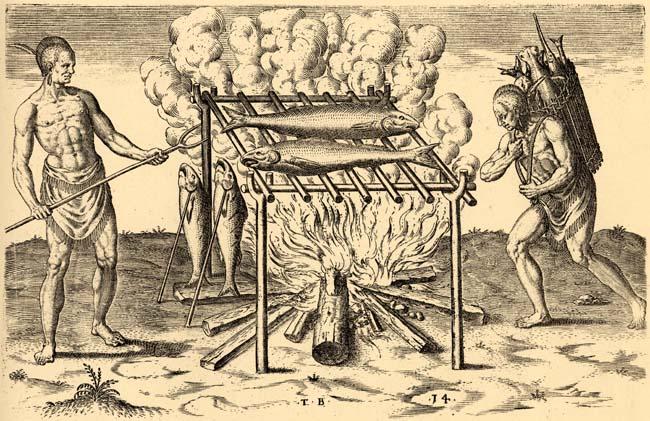Old portrait of Hernando de Soto
"The Brovvyllinge of Their Fishe ouer the Flame." Theodor de Bry's engraving of two American Indian men cooking fish, published in Thomas Hariot's 1588 book A Briefe and True Report of the New Found Land of Virginia. In the center, two large fish are lying on a grate over a fire. Two other fish hang suspended from sticks under the grate. The man on the left holds a long fork-like tool. The man on the right wears on his back a tall basket containing more fish.
The text accompanying the image reads:
After they have taken store of fish, they get them unto a place fit to dress it. There they stick up in the ground 4. stakes in a square room, and lay 4 posts [sticks] upon them, and others over thwart [crosswise] the same like unto an hurdle, of sufficient height, and laying their fish upon this hurdle, they make a fire underneath to broil the same, not after the manner of the people of Florida, which do but shorten, and harden their meat in the smoke only to Reserve the same during all the winter. For this people reserving nothing for store, they do broil, and spend away all at once and when they have further need, they roast or seethe fresh, as we shall see hereafter. And when as the hurdle can not hold all the fish, they hang the Rest by the fires on sticks set up in the ground against the fire, and then they finish the rest of their cookery. They take good heed that they be not burnt. When the first are broiled they lay others on, that were newly brought, continuing the dressing of their meat in this sort, until they think they have sufficient.
Theodor de Bry was a Flemish-born engraver and publisher who based his illustrations for Hariot's book on the New World paintings of colonist John White. These depictions of the landscapes and residents of North Carolina provided Europeans with some of their earliest notions of what the North American continent looked like. This engraving was based on White's watercolor painting, "Cooking Fish."

Public Domain
Public Domain is a copyright term that is often used when talking about copyright for creative works. Under U.S. copyright law, individual items that are in the public domain are items that are no longer protected by copyright law. This means that you do not need to request permission to re-use, re-publish or even change a copy of the item. Items enter the public domain under U.S. copyright law for a number of reasons: the original copyright may have expired; the item was created by the U.S. Federal Government or other governmental entity that views the things it creates as in the public domain; the work was never protected by copyright for some other reason related to how it was produced (for example, it was a speech that wasn't written down or recorded); or the work doesn't have enough originality to make it eligible for copyright protection.